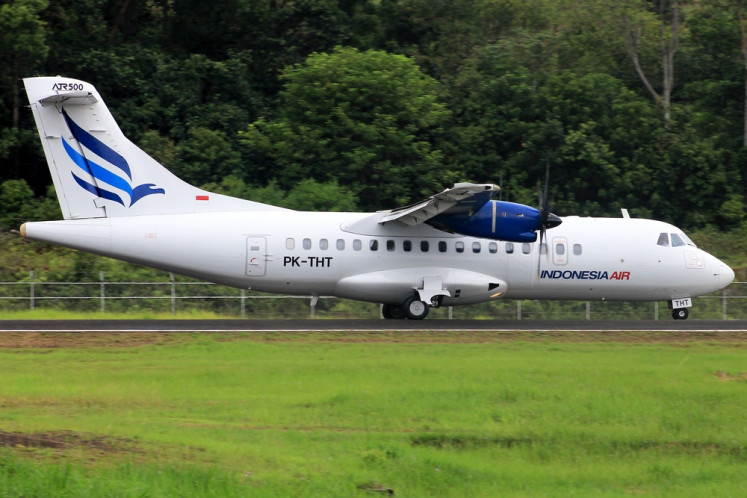Popular Reads
Top Results
Can't find what you're looking for?
View all search resultsPopular Reads
Top Results
Can't find what you're looking for?
View all search resultsStreet artists brighten up communities in Jakarta
Concrete canvas: Motorcyclists pass by a mural on Jl
Change text size
Gift Premium Articles
to Anyone
C
oncrete canvas: Motorcyclists pass by a mural on Jl. Inspeksi Sungai Ciliwung Lama in Kali Pasir, Central Jakarta, on Tuesday. The city administration gives local artists room for expression on numerous buildings across Jakarta and murals are seen as a way to brighten up densely populated urban areas. (JP/Dhoni Setiawan)
Nestled under a busy road in Central Jakarta, giant and vibrant murals greet passersby at the Kendal tunnel near the Dukuh Atas MRT station.
Anyone walking through the tunnel can enjoy a mural painting of a black and white “squid” monster figure with bulging eyes and teeth-like tentacles alongside an orange-blue majestic roaring lion on the walls.
Created in July 2019 and initiated by the Jakarta administration, the mural was painted by an Indonesian street artist who goes by the nickname Darbotz, and Snyder, a German street artist, to represent the 25 years of friendship between sister cities Berlin and Jakarta.
The 39-square-meter wall at the tunnel is also painted with other murals that pay homage to old-school public transportation services in Jakarta, such as the three-wheeler bajaj (motorized pedicab) and the medium-sized Metro Mini bus, the popularity of which has started to diminish.
The exuberant murals and the special space to showcase show that authorities and business players have started to embrace and hire street artists professionally, as the art form grows in popularity.
Starting his mural-painting illegally on the street, Darbotz is considered one of the most successful street artists in the country, having been involved in commercial partnerships with global brands such as DC shoes in 2017 and G-shock, a line of watches produced by Japanese watchmaker, Casio.
Street art has come along way with respect to its previous association with vandalism.
Communities like Gardu House and Visual Jalanan (Street Visual) have also challenged the conception of street art, with their achievements and positive campaigns through their works of art.
Officially established in 2010 in South Jakarta, Gardu House is more than just a hub for street artists and is now a space for street artists to express their passion.
Their major event “Street Dealin” has been held 12 times since 2011, bringing together a community of both local and international artists, often working solo and with little recognition for their work. During their latest event in December, the artists were involved in a five-day festival, consisting of mural paintings, community gatherings, art exhibitions, hip-hop parties and more.
The two-day activity of mural painting called “By Your Run Camp Project”, as part of the festival, was held to hone the artistic skills of the community's members. As many as 40 artists from Indonesia, Germany, China, Thailand, Singapore and Vietnam collaborated in a big-bombing mural painting project in the densely populated area of Kebayoran Lama district in South Jakarta.
The transfer of knowledge was also accommodated through a discussion forum during the event, when participants and speakers discussed the phenomenon of graffiti both historically and aesthetically.
“Drawing skills, or what we call spraycan control, can be developed through frequent practice. However, speaking of the painting technique, I believe that there are not many differences between local and international street artists,” Bayu Chris, an artist and a member of Gardu House told The Jakarta Post on Monday evening, adding that as many as 50 walls in three different kampung in the capital city have been painted by the street artists since the By Your Run project began in 2016.
He said current graffiti street art in Indonesia was mostly adapted as a form of aesthetic expression rather than rebellion.
"Street artists painted on the kampung walls to instill messages of social campaigns through pictures or symbols. [...] So for people in the kampung, the paintings are not only a form of art but are also a form of social communication," he added.
Another community called Forum Lenteng through its Visual Jalanan journal, has been recording visual activities on the street in various art forms and has been actively highlighting the positive messages of street art since 2012.
"The street is a blank 'canvas' on which anyone can freely inscribe meaning. However, freedom is not without cost — there is an ongoing negotiation or even confrontation in the public space. Laymen and artists can create visual objects on the streets, but the government can erase them while corporations relentlessly pursue advertising space," wrote Andang Kelana, the director of Visual Jalanan, on his website andangkelana.com.
He echoed the aforementioned street artists and said it was important for street art to have a purpose.
"The purpose of street art is to resist rather than to harm," he told the Post.
While these street art communities are thriving with their paintings and social awareness messages in urban spaces, they also provide emotional support for the street artists.
Oldi Jurakli, 33, was a street artist who now works as a graphic designer. He recalled his experiences with the street art community, stating that they helped him sharpen his skills as well as gaining a family. (trn)










